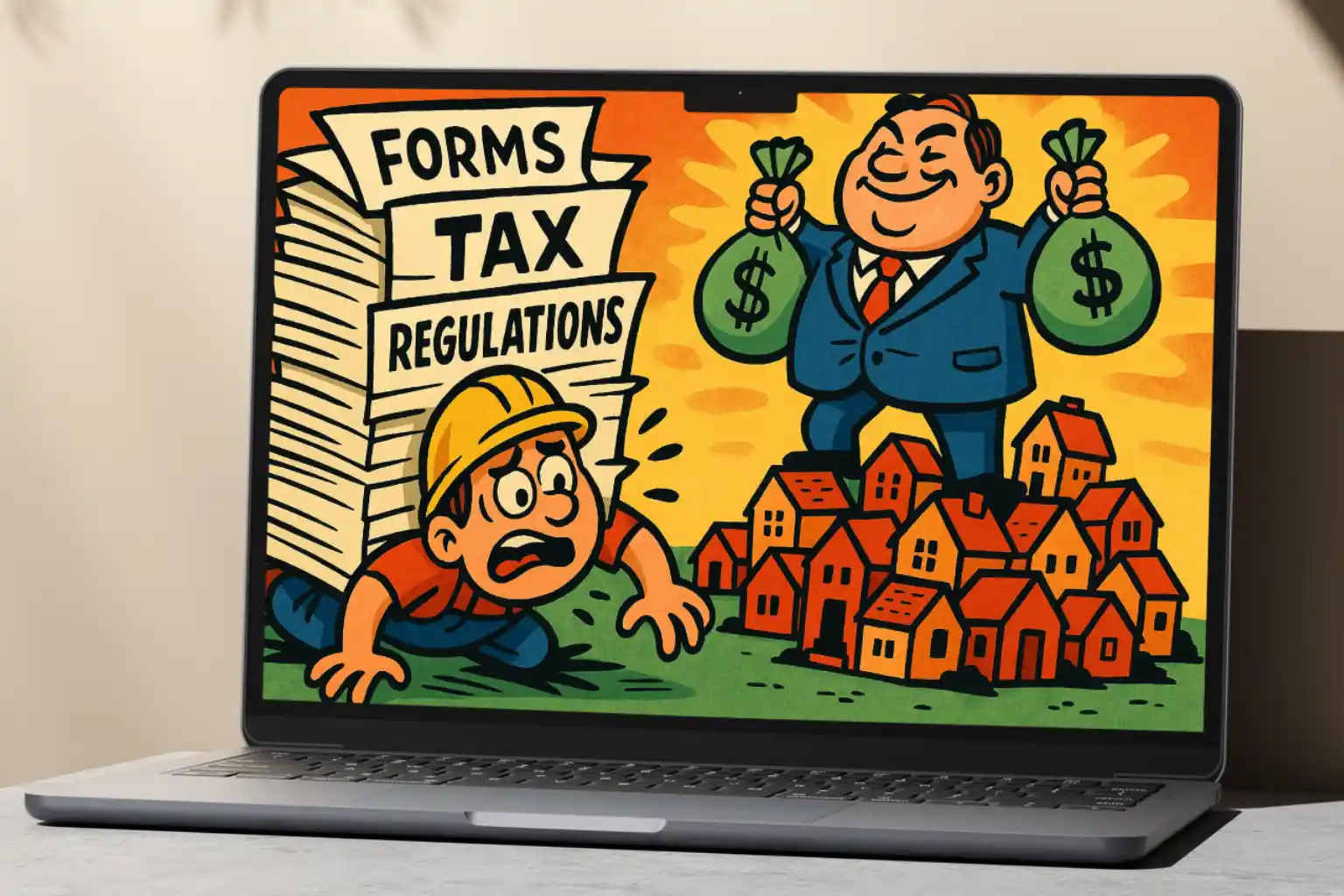For source references, see the note at the bottom of this article.

How the suits stitched up small builders while the big boys cleaned up
The Great Squeeze: What Really Happened
Back in the 80s, builders like you were knocking out nearly half the homes in Britain. Local firms building for local people. Forty percent of new homes came from SMEs.
Now you are hanging onto less than 10 percent. The other 90 percent is hoovered up by PLC developers with their accountants, lawyers, and boardroom lunches.
And let’s not forget, this is only new homes, not the government contracts you have been red taped out of.
Please do not believe the fairy tale that the market decided. This was not luck. It was engineered. Decades of tax tweaks and HMRC crackdowns, each one landing hardest on you.
Here is the thing. The big PLCs did not win by being better. They won because the rules changed, and the rules were changed deliberately to make it harder for you to survive.
Meanwhile, construction makes up 15.7% of all insolvencies in the UK in April 2025. Coincidence? I do not think so.
It was not competition. It was suffocation by paperwork.
Timeline of Madness
- 1984: Corporation tax. Big firms 52%, small firms 38%. For once, the little guy had the edge.
- 2007: CIS reforms. Deductions and admin on every invoice. Big firms breeze through on gross status.
- 2017: IR35 hits public sector. Risk pushed down the chain. Small firms left guessing their status.
- 2019: VAT reverse charge. Your VAT float disappears. Cash flow takes the hit.
- 2021: CIS gross tightened. Fewer qualify. IR35 extended to private sector. Flexibility gone, risk shifted to you.
- 2023: Making Tax Digital ramps up. Software, training, subscriptions. Big firms already digitised.
- 2024: Companies House ID checks. You wait weeks. They call the solicitors.
Same rules on paper. Different world in practice.
The Pandemic Window
Between 2020 and 2022, while you worried if work would restart, a stack of rules landed fast:
- VAT reverse charge
- CIS verification tightening
- IR35 private sector rollout
- Making Tax Digital expansion
- Companies House reforms
These were not written in a rush. They were sitting on a shelf, ready to drop. This was not a rescue. It was a raid.
VAT Reverse Charge: Why Your Cash Flow Vanished
You have heard of it. You have wrestled with it. It did not stop fraud. It stopped your cash flow.
Before 2021 it was simple. Send the invoice. Get paid. Pay HMRC the VAT later.
Now the contractor holds the VAT and pays HMRC after the developer pays them. If the developer pays in 60 days, your VAT is stuck for 60. If they stretch to 90, you wait 90.
HMRC still wants its cut on time. Miss it and you get penalties. You are now funding their cash flow, not yours.
The big boys do not blink. They have reserves, overdrafts, and accountants on speed dial. You are just trying to pay the lads on Friday.
CIS: From Simple to Stitch Up
They sold CIS as cleaning up the industry. The truth is the bloke with a brown envelope on a Saturday was not the problem. He was feeding his kids.
Meanwhile the corporates use umbrellas, offsets, and clever write offs. Legal, but it stinks. So why is their way fine and the brickie’s not?
No gross payment status means 20% chopped off before you touch it. Do ten grand of graft and you see eight. That missing two grand sits with HMRC until you file the return, often more than a year later.
You are financing their cash flow. The big firms have gross status and in house teams. They do not feel it. You feel it on payday.
MTD: Making Tax Difficult
Making Tax Digital sounds modern. In practice it is more software, more training, and more time when you should be building.
Quarterly updates. Digital records. Miss a quarter and you collect penalty points. Hit three and it is a £200 fine.
Big developers have had slick systems for years. You are on an old laptop with Excel and a prayer.
The Extra Costs Stack
- Biodiversity report: about £7,500
- Future Homes air tightness and related testing: about £6,000
- Insurance that has jumped by half
- Highways reports even when you are under ten homes
That is nearly twenty grand added to a small site. Big firms spread it over 500 homes. You spread it over five. There goes your margin.
You walk away. The site sits. Then the government asks why homes are not being built. We are not refusing to build them. We are being priced out of building them.
Case Study: The £20k Builder
A small builder putting up five houses in 2025 faces:
- CIS deductions and admin: £2,500
- Biodiversity Net Gain surveys: £7,500
- Future Homes Standard testing: £6,000
- Insurance hikes post reform: £3,000
Total added cost: £19,000.
That is the profit gone. Project shelved. A Persimmon or Barratt spreads nineteen grand over 500 houses and barely notices.
Conclusion
This was not oops we forgot the little guys. It was a long term strategy. Dressed up as safety, green rules, and anti fraud, but every step pushed small builders out.
- Less competition, higher prices for homeowners
- Fewer homes built, the housing crisis gets worse
- Local builders disappear, profits siphoned to shareholders abroad
- Copy paste estates, no community
What Needs Fixing
- Exempt builders doing fewer than ten units a year from CIS deductions
- Scrap IR35 headaches for sole traders in construction
- Cap umbrella company fees at five percent
- Give all new builders three years of automatic gross payment status
- Provide a one off £500 digital grant for MTD software
- Require councils to award at least 30 percent of contracts to SMEs
- Reform business rates so they do not hammer small companies
Final Word
We all know that list will not get touched. They all drink in the same club. They can afford to bribe, blackmail, and twist arms until the rules keep you small and keep them fat.
If you want change, it takes numbers and real effort. Not violence. Not protests and petitions. Those only show you accept their authority then refuse to comply, which brings fines and jail.
There is a better way. Quiet. Clever. Legal. The pen, not the sword. Farmers are learning it already to protect themselves and their kids. Construction can do the same.
I hope there are still enough real men in this industry with the guts to take back what is theirs. The right to compete on a fair field. If that is you, get in touch.
I am building a free group with tools and tactics to level the field. It needs numbers. Numbers mean strength.
Verified Sources
- HMRC, Historical Corporation Tax Rates
- HMRC, Construction Industry Scheme reform papers and guidance
- HMRC, IR35 guidance, public sector and private sector
- HMRC, VAT domestic reverse charge guidance for construction
- HMRC, Making Tax Digital for ITSA policy and updates
- Companies House, Corporate Transparency and Register Reform
- Office for National Statistics, Business insolvency statistics, April 2025
- National Audit Office, Tax reliefs and compliance burdens review
- DEFRA, Biodiversity Net Gain guidance
- DLUHC, Future Homes Standard technical requirements
- Association of British Insurers, SME insurance market review
- Chronological Timeline of UK Building and Construction Regulations, 1980 to 2025
All source documents referenced in this blog are maintained on our Verified Sources page.
